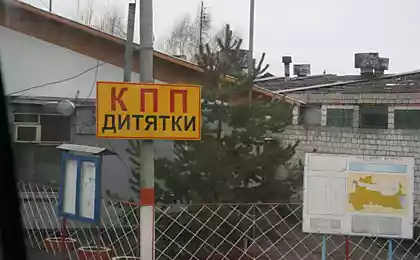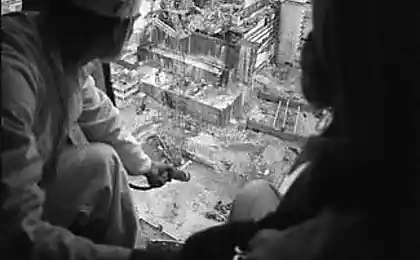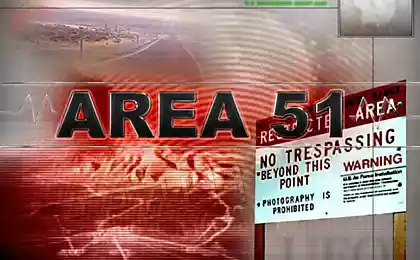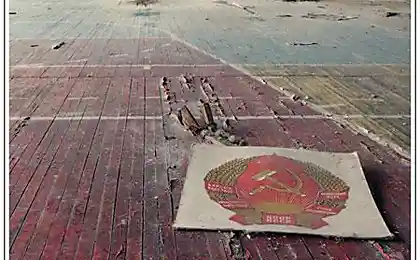1669
Flying over Chernobyl: top view
Writes Alexander Cheban:
Soft paint early in the morning, the remnants of the early morning mist in rivers ... and the dead city of Pripyat near the Chernobyl nuclear power plant, probably no more dissonance than here. Seen from a height of 10 thousand meters forced to recall the emotions that I felt visiting Pripyat in the 2006th, as the top lot of distinguishable details. The city, which stood in the eighties, and now gradually give up step on the forest ... In terms of the emotional load of Pripyat is on a par with Auschwitz among all the places I've visited.

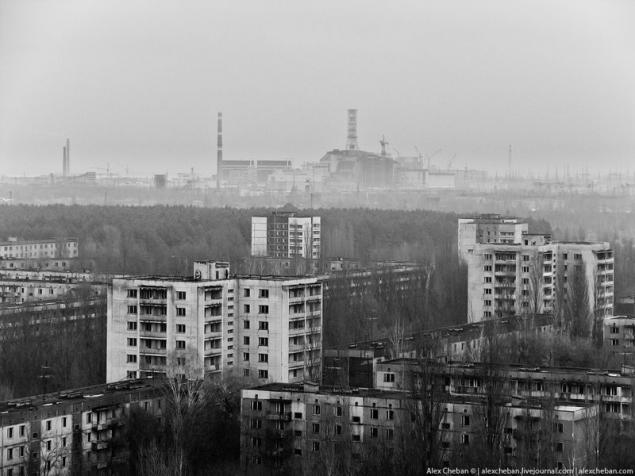
Morning mist over the Kiev area immediately after takeoff ...

Gostomel airfield, the base airport is the world's largest aircraft An-225 "Mriya»:
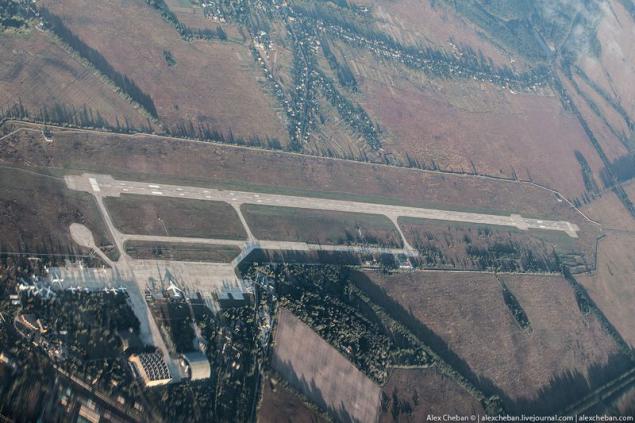
Large airplanes - is An124 "Ruslan", "Mriya" is in a hangar at the bottom right, the tail is visible in the photograph.

Just 15 minutes after takeoff, I noticed an object "Chernobyl-2", and after 2-3 minutes and saw the very Chernobyl nuclear power plant and Pripyat. Very early in the morning and shot with a height of 10 thousand meters is not very comparable conditions, so these photos photofact more than acceptable quality.
The object of "Chernobyl-2" 27 years ago it was a top-secret facility allows you to monitor the movement of all types of above-ground goals not only over Europe, but also made it possible to pinpoint potential enemy launches in North America. Thanks to these capabilities, this complex was named "Duga 1" (Radio Centre-distance telecommunications Chernobyl-2). According to available information, Duga consume about 10 megawatts. It is obvious that the construction of a nuclear power plant near Duga due to the large energy of the object.

Date and place of construction of the first Duga: 1975, Komsomolsk-on-Amur The first pilot inclusion of OTH-Radar Chornobyl-2: 1980. According to some sources, the cost of capital amounted to seven billion Soviet rubles. For comparison - it is twice as expensive as the construction of the Chernobyl NPP. Near the radar, built near the town of Chernobyl, it was established a garrison, where they lived the military and their families.

Full closure of the infrastructure of the city Chernobyl-2 was carried out at once: before 1987 it was closed down. But over time it became clear that it operated under the exclusion zone is impossible. The basic units of Duga were dismantled and taken to the city of Komsomolsk-on-Amur.
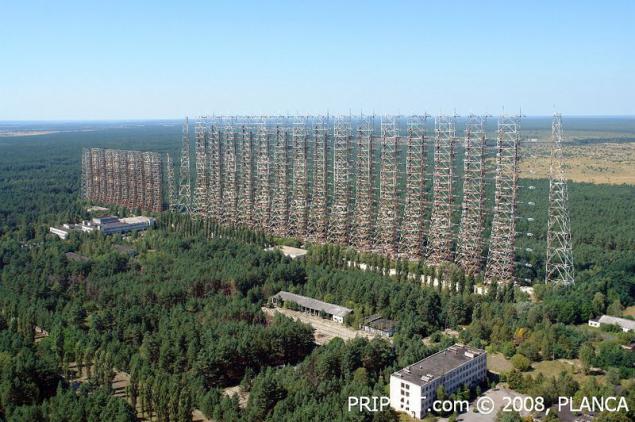
In April 2012 the Ukrainian BASE jumpers five of them for the first time made the leap from the station.

And this is Chernobyl nuclear power plant and the city of Pripyat, just a few kilometers between them:

Slightly higher on the nuclear power plant in this picture is "Red Forest»:
As a result of the Chernobyl accident, tens of thousands of hectares of forests have experienced a powerful radioactive pollution, a total length of about two kilometers to the west of the station and in the immediate vicinity of the Chernobyl nuclear power plant. According to the degree of radiation exposure was found four of the affected area. The first zone - the zone of total loss of conifers with partial damage to hardwoods (the so-called Red Forest). The levels of absorbed dose (of the scientists) external gamma radiation in 1986-1987 amounted to 8000-10000 pleased at the maximum exposure dose - 500 mR / h and more. This area is about 4, 5000 hectare. On the night of the explosion at Unit 4, these trees are subjected to powerful radiation, causing acquired unnatural red color.



It looked like the 4th power unit after the accident:

This is the 4th unit of Chernobyl nuclear power plant and the initial "sarcophagus" over it. The construction of "Shelter" It took 400 thousand cubic meters of concrete and 7,000 tons of steel. It was built in the shortest possible time - 206 days. The construction of "Shelter" has been involved 90 thousand people. Later, the building was given the unofficial name of "Sarcophagus».
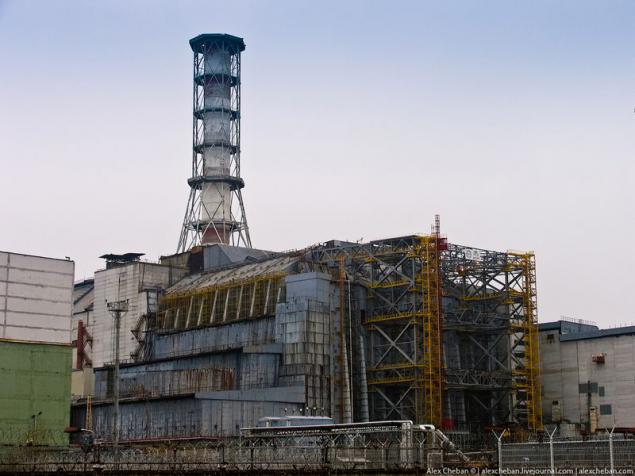
Currently, due to the danger of the destruction of the sarcophagus over the 4th power unit of Chernobyl nuclear power plant works on the transformation of the "Shelter" into an ecologically safe system. This work is scheduled to finish in 2015.

The new facility will be a solid steel structure height of 108 m and 150 m in length, which will be technological building and auxiliary facilities:



And the city of Pripyat:


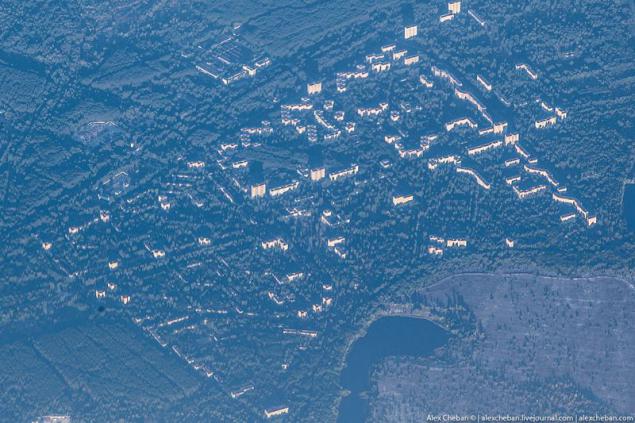
The central area of the city of Pripyat (photo from chetyrnadtsatietazhki, it is now no access to the threat of collapse):

NPP very close:
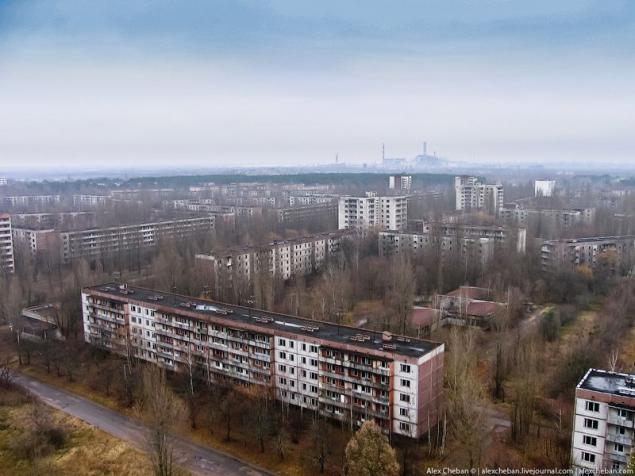

Palace of Culture "Energetic»:

Ferris wheel and amusement park




Source: alexcheban.livejournal.com
Soft paint early in the morning, the remnants of the early morning mist in rivers ... and the dead city of Pripyat near the Chernobyl nuclear power plant, probably no more dissonance than here. Seen from a height of 10 thousand meters forced to recall the emotions that I felt visiting Pripyat in the 2006th, as the top lot of distinguishable details. The city, which stood in the eighties, and now gradually give up step on the forest ... In terms of the emotional load of Pripyat is on a par with Auschwitz among all the places I've visited.


Morning mist over the Kiev area immediately after takeoff ...

Gostomel airfield, the base airport is the world's largest aircraft An-225 "Mriya»:

Large airplanes - is An124 "Ruslan", "Mriya" is in a hangar at the bottom right, the tail is visible in the photograph.

Just 15 minutes after takeoff, I noticed an object "Chernobyl-2", and after 2-3 minutes and saw the very Chernobyl nuclear power plant and Pripyat. Very early in the morning and shot with a height of 10 thousand meters is not very comparable conditions, so these photos photofact more than acceptable quality.
The object of "Chernobyl-2" 27 years ago it was a top-secret facility allows you to monitor the movement of all types of above-ground goals not only over Europe, but also made it possible to pinpoint potential enemy launches in North America. Thanks to these capabilities, this complex was named "Duga 1" (Radio Centre-distance telecommunications Chernobyl-2). According to available information, Duga consume about 10 megawatts. It is obvious that the construction of a nuclear power plant near Duga due to the large energy of the object.

Date and place of construction of the first Duga: 1975, Komsomolsk-on-Amur The first pilot inclusion of OTH-Radar Chornobyl-2: 1980. According to some sources, the cost of capital amounted to seven billion Soviet rubles. For comparison - it is twice as expensive as the construction of the Chernobyl NPP. Near the radar, built near the town of Chernobyl, it was established a garrison, where they lived the military and their families.

Full closure of the infrastructure of the city Chernobyl-2 was carried out at once: before 1987 it was closed down. But over time it became clear that it operated under the exclusion zone is impossible. The basic units of Duga were dismantled and taken to the city of Komsomolsk-on-Amur.

In April 2012 the Ukrainian BASE jumpers five of them for the first time made the leap from the station.

And this is Chernobyl nuclear power plant and the city of Pripyat, just a few kilometers between them:

Slightly higher on the nuclear power plant in this picture is "Red Forest»:
As a result of the Chernobyl accident, tens of thousands of hectares of forests have experienced a powerful radioactive pollution, a total length of about two kilometers to the west of the station and in the immediate vicinity of the Chernobyl nuclear power plant. According to the degree of radiation exposure was found four of the affected area. The first zone - the zone of total loss of conifers with partial damage to hardwoods (the so-called Red Forest). The levels of absorbed dose (of the scientists) external gamma radiation in 1986-1987 amounted to 8000-10000 pleased at the maximum exposure dose - 500 mR / h and more. This area is about 4, 5000 hectare. On the night of the explosion at Unit 4, these trees are subjected to powerful radiation, causing acquired unnatural red color.



It looked like the 4th power unit after the accident:

This is the 4th unit of Chernobyl nuclear power plant and the initial "sarcophagus" over it. The construction of "Shelter" It took 400 thousand cubic meters of concrete and 7,000 tons of steel. It was built in the shortest possible time - 206 days. The construction of "Shelter" has been involved 90 thousand people. Later, the building was given the unofficial name of "Sarcophagus».

Currently, due to the danger of the destruction of the sarcophagus over the 4th power unit of Chernobyl nuclear power plant works on the transformation of the "Shelter" into an ecologically safe system. This work is scheduled to finish in 2015.

The new facility will be a solid steel structure height of 108 m and 150 m in length, which will be technological building and auxiliary facilities:



And the city of Pripyat:



The central area of the city of Pripyat (photo from chetyrnadtsatietazhki, it is now no access to the threat of collapse):

NPP very close:


Palace of Culture "Energetic»:

Ferris wheel and amusement park




Source: alexcheban.livejournal.com






